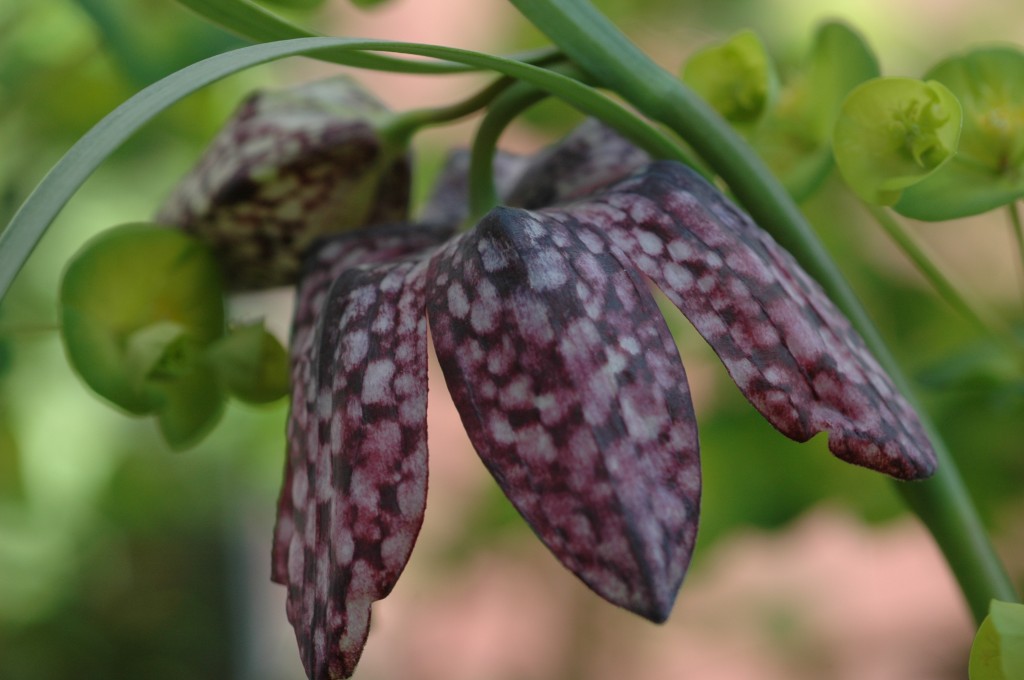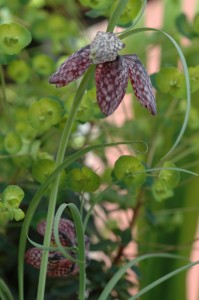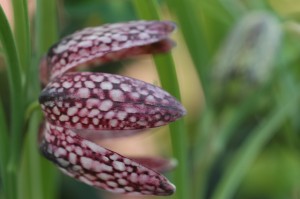 A million roadblocks stand between tulips and me. If they aren’t sabotaged by rodents, deer do them in. Tulips happen here, but sometimes it’s nice to grow a plant that doesn’t require dowsing with fermented salmon and rotten eggs, if you catch my drift. That’s why I turned to Fritillaria meleagris. They don’t have the same shock appeal, but they survive without strategic arms.
A million roadblocks stand between tulips and me. If they aren’t sabotaged by rodents, deer do them in. Tulips happen here, but sometimes it’s nice to grow a plant that doesn’t require dowsing with fermented salmon and rotten eggs, if you catch my drift. That’s why I turned to Fritillaria meleagris. They don’t have the same shock appeal, but they survive without strategic arms.
A Fritillaria meleagris in the garden isn’t going to stop traffic, but it is a subtly graceful thing. If it were in prep school, it would be in the Ralph Lauren league, with its natty checkered outfit and crisply pointed petals. And just like the designer ads, it would have an attitude, dangling saucily from its arched stem. But let’s get real — no matter how fetchingly you’re tricked out — deep maroon, downward facing flowers aren’t going to be doorbusters competing against lilacs, hyacinths and the like. Take them right out of that beauty pageant, I say. Instead, grow fritillarias indoors in the dead of winter.
 No, I’m not delusional (yet). Fritillaria meleagris is a great forcer. Absolutely primo. But they certainly haven’t hit the supermarket circuit for that purpose. In fact, I might be one of the only folks in on this secret (leak alert). And I only discovered fritillaria’s forcibility by accident. Somehow, the ground froze before I could finish my bulb fanaticism this year (we’re talking 2,500 bulbs successfully inserted before seize up — but that’s another story). Not to be dissuaded in my derangement, I rounded up all the containers within reach and began potting. The refrigerator filled up with tulips and narcissus in no time (more about my frig follies in www.gardeninggonewild.com. It was looking like the frits wouldn’t be left out in the cold.
No, I’m not delusional (yet). Fritillaria meleagris is a great forcer. Absolutely primo. But they certainly haven’t hit the supermarket circuit for that purpose. In fact, I might be one of the only folks in on this secret (leak alert). And I only discovered fritillaria’s forcibility by accident. Somehow, the ground froze before I could finish my bulb fanaticism this year (we’re talking 2,500 bulbs successfully inserted before seize up — but that’s another story). Not to be dissuaded in my derangement, I rounded up all the containers within reach and began potting. The refrigerator filled up with tulips and narcissus in no time (more about my frig follies in www.gardeninggonewild.com. It was looking like the frits wouldn’t be left out in the cold.
Fortunately, that’s when I happened to get on the phone with Brent Heath www.brentandbeckysbulbs.com and The Bulbmeister revealed that fritillarias prefer 50-60 degrees F for a few weeks, which sounded a lot like home to me this winter. So I gave it a try. I simply put my pots of fritillarias beside a cool window. It was a bingo.
 The ballet has lasted a month already. At my elbow at the moment are curlicues of foliage shouldering dangling bells with checkerboard markings in various tints of cranberry. What blended right in with the understory in the garden sparkles in the windowsill. Since I’m short of space, I can give them only east-facing light, which is fine with them. I water them when they dry out (which is often), and I’m rewarded by jewel-like blossoms. But the best news? They don’t smell like skunks! That might not sound like something to turn cartwheels about, but when you’re related to a crown imperial (Fritillaria meleagris), people expect bad fumes to pour from your mouth. Well, Fritillaria meleagris does not offend. Not a little stinker. Not even remotely, not even slightly. Pure sophistication. In mid-February, it doesn’t get any better than this.
The ballet has lasted a month already. At my elbow at the moment are curlicues of foliage shouldering dangling bells with checkerboard markings in various tints of cranberry. What blended right in with the understory in the garden sparkles in the windowsill. Since I’m short of space, I can give them only east-facing light, which is fine with them. I water them when they dry out (which is often), and I’m rewarded by jewel-like blossoms. But the best news? They don’t smell like skunks! That might not sound like something to turn cartwheels about, but when you’re related to a crown imperial (Fritillaria meleagris), people expect bad fumes to pour from your mouth. Well, Fritillaria meleagris does not offend. Not a little stinker. Not even remotely, not even slightly. Pure sophistication. In mid-February, it doesn’t get any better than this.
All photographs copyright Tovah Martin
